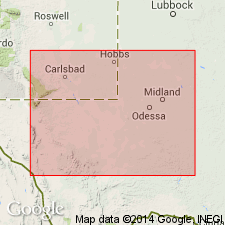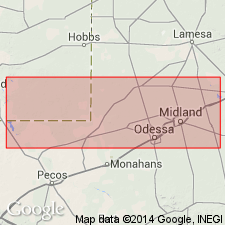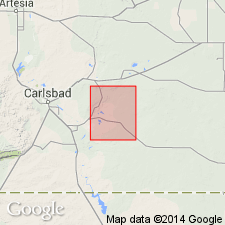
- Usage in publication:
-
- Pierce Canyon redbeds*
- Modifications:
-
- Named
- Dominant lithology:
-
- Shale
- Sandstone
- AAPG geologic province:
-
- Permian basin
Summary:
Name applied to a series of fine sandy to earthy redbeds, green polka-dotted and irregularly veined with thin selenite fillings. Estimated to be 350 ft thick over most of the Permian basin. No "favorable" exposures found. "Fair outcrop" present in Pierce Canyon, southeast of Loving, Eddy Co, NM in the Permian basin. No type locality designated. Unconformably underlain by Rustler formation. Triassic age. Cross section.
Source: GNU records (USGS DDS-6; Denver GNULEX).

- Usage in publication:
-
- Pierce Canyon Redbeds
- Modifications:
-
- Not used
Summary:
Redbeds above Rustler Formation make a single lithologic unit. The name Dewey Lake Redbeds applied to these rocks which lie above the Rustler Formation and beneath Santa Rosa Sandstone, or Ogallala Formation in west (Eddy Co, NM to Loving Co, TX) and beneath Tecovas Formation in east (Winkler to Glassock Cos, TX) Permian basin. Use of Dewey Lake supercedes use of Pierce Canyon Redbeds in report area. Earlier reports assigned the redbeds to Pierce Canyon of Triassic age or Dewey Lake of Permian age. Assignment of redbeds to Permian and hence to Dewey Lake substantiated by the following lithologic criteria: 1) abundant small round to subround green to gray reduction spots, 2) gypsum as a common cementing agent, 3) light-colored mica common accessory mineral.
Source: GNU records (USGS DDS-6; Denver GNULEX).

- Usage in publication:
-
- Pierce Canyon redbeds*
- Modifications:
-
- Overview
- AAPG geologic province:
-
- Permian basin
Summary:
Name used in report area, Eddy Co., NM in the Permian basin for rocks above the newly named Forty-niner member, upper member of the Rustler formation, and unconformably beneath the Santa Rosa sandstone. Mapped (geologic map) in northern, central, and south-central parts of quad. Footnote at base of map states that name Dewey Lake redbeds (a name commonly used by petroleum geologists) preferred to Pierce Canyon redbeds; this decision was made after the report was prepared. Name applied to some red-orange to red-brown sandstone and siltstone that is thinly laminated and has small scale cross laminae, small current and oscillation ripple marks. Subangular to subround clear quartz is the most abundant single mineral; chert and feldspar are the next most abundant. Uniform in color and lithology. Measured section. Stratigraphic table. Drillhole samples described. Assigned to the Permian because the redbeds most closely resemble other Permian rocks.
Source: GNU records (USGS DDS-6; Denver GNULEX).
For more information, please contact Nancy Stamm, Geologic Names Committee Secretary.
Asterisk (*) indicates published by U.S. Geological Survey authors.
"No current usage" (†) implies that a name has been abandoned or has fallen into disuse. Former usage and, if known, replacement name given in parentheses ( ).
Slash (/) indicates name conflicts with nomenclatural guidelines (CSN, 1933; ACSN, 1961, 1970; NACSN, 1983, 2005, 2021). May be explained within brackets ([ ]).

